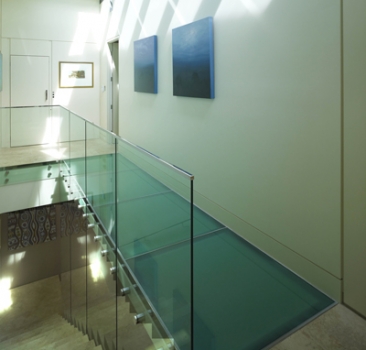
Image courtesy of Viridian.
Glass floors provide a range of options which you won’t get with any other flooring type, simply because glass is transparent. This means it can allow light to pass through it. If glass floors are used on upper floors, they can significantly reduce your reliance on artificial light by allowing natural light to do the work. Glass floors are also commonly used to show off a particular view or feature beneath, and are often inset into another floor type.
Acrylic flooring acts the same way to some degree too as it is opaque, letting some light through but not enough to see clear distinct images. Acrylic floors are commonly used in backlit dance floors at discos and nightclubs. Acrylic panels can also be inset into existing flooring types for the purpose of lighting.
What should I look for in glass and acrylic floors?
Glass floors will need toughened laminated glass; anything less will be unsafe to walk on. The required thickness will vary depending on how large each panel is, but 50mm is common. Because the panels need to be so thick, the glass will be quite heavy and will require proper reinforcement. For this, you will need to consult with a structural engineer. They will advise you on glass thickness and framing requirements, design a floor to your needs and advise you on everything you need to have done.
It's also worth noting that glass floors can get very slippery when they're wet. This can be mitigated to a certain degree by etched patterns on the surface, which can provide both grip and aesthetic appeal.
Acrylic floor panels should be thick enough to bear the load capacity you expect them to carry, but are much lighter than glass as a material and therefore easier to frame.
How are glass and acrylic floors installed?
Once the plans for the floor have been drawn up, the framing perimeter is affixed to the wall, supported underneath by beams. Framing spacers are then set for the first row of glass panels along with cushioning strips. The edges of the glass are taped to prevent chipping and are set into place. Once all the panels have been laid, the edges of each are sealed with silicon and the tape is removed. The floor is ready for use once the silicon has dried.
Acrylic floor panels can be installed in much the same way, though premade modules containing lighting may take the time and effort out of having separate lighting installed.
Suitability and maintenance
Glass floors add a beautiful feature to a home and are often novel focal points for exotic balconies and mezzanines. For this reason, they are usually found in multi storey dwellings where there is something to see beneath the glass. They can also be used in feature stairwells as steps, and look especially effective in spiral staircases. Acrylic floors are often used as lighting features inset into a floor.
Both acrylics and glass are non-porous so can be easily mopped, but glass may need a polish afterwards to prevent streaking. Both surfaces need to be guarded as much as possible against scratching. Scratches are permanent and can gather grime and dirt and become very obvious over time.
|
Advantages
|
Disadvantages
|